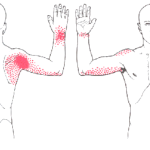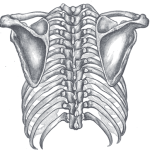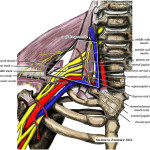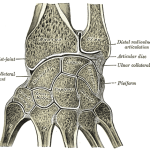Introduction
Sports physiotherapists regularly assess and treat shoulder pathologies. In my clinical practice, shoulders would place in the top 3 most common conditions (along with back and knee presentations). Given the frequency with which we see these problems, there is much interest in the best assessment and rehabilitation techniques for shoulder problems. This article will discuss new research on assessing the position of the scapula.
What Do We Know About Scapula Position?
It has been well established that patients with shoulder pathologies e.g. subacromial impingement syndrome, glenohumeral instability etc, exhibit abnormal scapular kinematics shoulder during arm elevation (Kibler et al., 2003). Scapular dyskinesis, as this impairment is known, has been well discussed on this site previously. This is because we know that identifying abnormal scapular kinematics is an essential component of a comprehensive shoulder examination.
As you will read in our previous post, assessment of scapular dyskinesis (check it out if you haven’t already), a reliable and comprehensive assessment system for scapular mechanics is challenging! Clinically, we make the assumption that healthy individuals will have symmetrical scapular mechanics, and therefore, in those with pathology we compare differences and assume that they are abnormal (Kibler et al., 2002). However, robust evidence supporting such an assumption is lacking, as there is the real potential for dominance driven differences in scapular position (Lukasiewicz et al., 1999; Oyama et al., 2008; Matias and Pascoal, 2006; Uhl et al., 2009).
Therefore, there is the research requirement to validate the assumption that scapular position is symmetrical…. to the research.
New Research On Assessing Scapular Position
Morais and Pascoal (2013) attempted to describe and compare 3D scapular kinematics of dominant and non-dominant shoulders in healthy individuals. The authors hypothesis was that there would be no difference on the 3D positioning of the scapula between sides.
To evaluate this hypothesis the authors assessed the 3D kinematics of the scapula and thorax by means of a 6 degrees of freedom (6DOF) electromagnetic tracking device in 14 young adults (m=7). Importantly, none of the subjects had a history of pain on the upper quadrant over the past 6 months or the involvement on asymmetric overhead sports activities on a regular basis.
What Did They Assess?
The authors evaluated the 3D scapular kinematics i.e.
- Protraction/Retraction
- Upward/Downward Rotation
- Anterior/Posterior Tilt
These variables were assessed in standing in 3 positions of abduction:
- Arms alongside the trunk (0º)
- Hands on hips (45º)
- 90º of shoulder abduction with internal rotation
Results of The Research
The authors found some interesting results. The results were that the resting position of the dominant shoulder demonstrated:
- Increased retraction (mean difference 19.3º)
- Increased upward rotation (mean difference 16.7º)
Interestingly, when the subjects moved from 0º to 90º abduction the amount of scapular movement was similar despite dominance, specifically increased:
- Retraction (mean dominant and non-dominant both 7.2º)
- Upward rotation (mean dominant 17.4º vs. 17.8º for non-dominant)
- Posterior tilt (mean dominant 3.8º vs. 0.9º for non-dominant)
Thus, in this healthy population there was a difference in initial (or resting) scapular position, however, both scapulae moved a similar amount from 0 – 90º abduction.
Comparison To And Thoughts On Previous Research
Oyama et al. (2008) evaluated the resting scapular position in 43 asymptomatic overhead athletes (15 pitchers, 15 volleyballers, 13 tennis players). They found that in this population the dominant scapular demonstrated increased:
- Internal rotation (mean difference 3.9º)
- Anterior tilt (mean difference 1.9º)
- Protraction, in tennis players only (mean difference 5.9º)
As you can see, there are slight differences in the results of Morais and Pascoal (2013) and Oyami et al. (2008). This is most likely due to the differences in population i.e. the overhead athletes. Such repetitive use is likely to result in specific dominant sided adaptations in the scapulo-thoracic muscles. The differences noted are indicative of a type 1 scapular dyskinesis (inferior angle prominece) and possible associated shortening of pectoralis minor (Borstad and Ludewig, 2005).
Therefore, when assessing posture and scapular position it is important to be aware of who you are looking at, not just what.
Clinical Implications of This Research
The take home messages from this research are:
- Side-to-side differences might be expected in healthy shoulders
- Hand dominance impacts the resting scapular position differently in various populations
- The pattern and the magnitude of scapular rotation through shoulder abduction is similar on both shoulders
- Clinically – differences in dynamic scapula kinematics are indicative are more useful indicators pathology than static.
Please note:It is widely accepted and considered best practice to prescribe specific exercises and perform manual techniques to correct abnormalities in scapula position/motion to improve function and reduce shoulder pain (Burkhart et al., 2003; Cools et al., 2007; Reinold et al., 2009; ). This is discussed in our previous post on treating scapula dyskinesis.
What Are Your Thoughts?
What are your experiences assessing scapula position? Where you find it easy or hate it – be sure to let me know in the comments, or you could:
Promote Your Clinic: Are you a physiotherapist or physical therapist looking to promote your own clinic? Check this out.
References
Borstad JD, Ludewig PM. The effect of long versus short pectoralis minor resting length on scapular kinematics in healthy individuals. J Orthop Sports Phys Ther 2005;35(4):227-38.
Burkhart SS, Morgan CD, Kibler WB. The disabled throwing shoulder: spectrum of pathology part III: the SICK scapula, scapular dyskinesis, the kinetic chain, and rehabilitation. Arthroscopy 2003;19(6):641e61.
Cools AM, Dewitte V, Lanszweert F, et al. Rehabilitation of scapular muscle balance: which exercises to prescribe? Am J Sports Med. 2007;35:1744-1751.
Kibler WB, Uhl TL, Madduz JW, Brooks PV, Zeller B, McMullen J. Qualitative clinical evaluation of scapular dysfunction: a reliability study. J Shoulder Elbow Surg. 2002;11(6):550-556.
Kibler WB, McMullen J: Scapular dyskinesis and its relation to shoulder pain. J Am Acad Orthop Surg. 2003;11:142-151.
Ludewig PM, Cook TM. Alterations in shoulder kinematics and associated muscle activity in people with symptoms of shoulder impingement. Phys Ther 2000;80:276–91.
Lukasiewicz AC, McClure P, Michener L, Pratt N, Sennett B. Comparison of 3- dimensional scapular position and orientation between subjects with and without shoulder impingement. J Orthop Sports Phys Ther 1999;29(10):574-83.
Matias R, Pascoal AG. The unstable shoulder in arm elevation: a three-dimensional and electromyographic study in subjects with glenohumeral instability. Clin Biomech (Bristol, Avon) 2006;21(Suppl. 1):S52-8.
Morais NV, Pascoal AG. Scapular positioning assessment: Is side-to-side comparison clinically acceptable? Manual Therapy 2013;18: 46-53
Oyama S, Myers JB, Wassinger CA, Ricci RD, Lephart SM. Asymmetric resting scapular posture in healthy overhead athletes. J Athl Train 2008;43(6):565-70.
Reinold MM, Escamilla R, Wilk KE. Current concepts in the scientific and clinical rationale behind exercises for glenohumeral and scapulothoracic musculature. J Orthop Sports Phys Ther 2009; 39(2):105-117.
Uhl TL, Kibler WB, Gecewich B, Tripp BL. Evaluation of clinical assessment methods for scapular dyskinesis. Arthroscopy 2009;25(11):1240e8.
Photo Credit:
Related Posts










